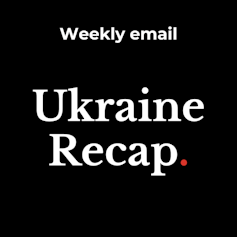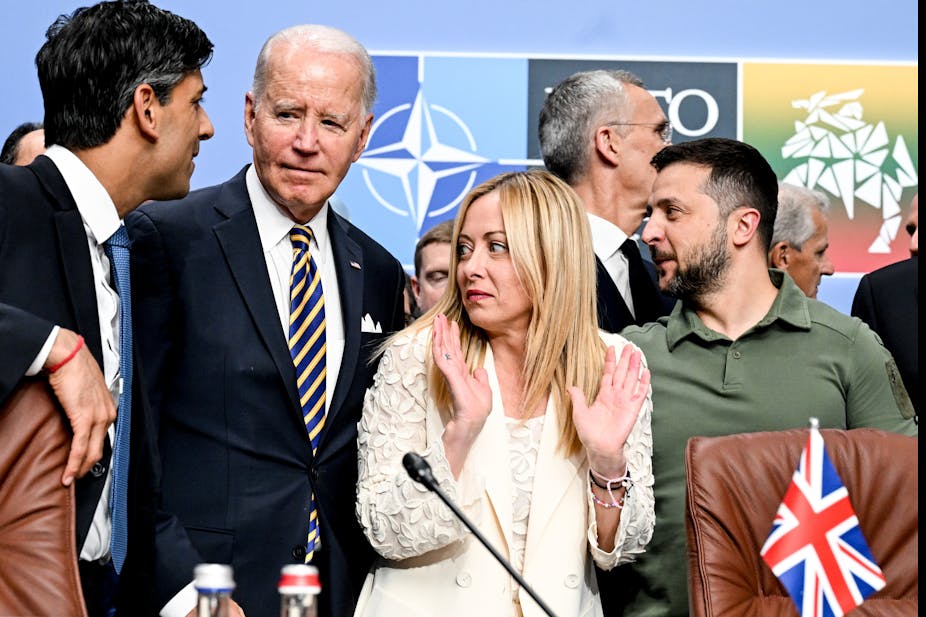For the past week or so it has felt as if Ukraine’s fate is more likely to be decided in Washington and Brussels than on the battlefield as US president Joe Biden struggles to get his US$111 billion (£88 billion) package of aid through the senate and EU members quibble over a €50 billion euro (£43 billion) lifeline for Kyiv.
“History is going to judge harshly those who turn their back on freedom’s cause. We can’t let Putin win,” Biden said after a video meeting with G7 leaders. But with all 49 Republican senators voting against the aid package, it remains stalled. And the recent electoral triumph of far-right candidates in Slovakia and the Netherlands and the intransigence of Hungary means that European solidarity behind Ukraine appears to be beginning to crumble.
Meanwhile Russia continues to be a diplomatic wrecking ball. Last week foreign minister Sergei Lavrov attended the annual ministers’ meeting of the Organization for Security and Cooperation in Europe (OSCE), which is fast becoming an oxymoron. Ukraine, Poland and the Baltic states refused to send their foreign ministers to the meeting over Lavrov’s presence, while the US’s Antony Blinken and UK’s David Cameron attended a pre-conference dinner but avoided any contact with Lavrov.
Meanwhile Lavrov blocked the appointment of Estonia as chair for the OSCE in 2024 (a non-Nato member – Malta – has been chosen instead). A three-year extension to the mandate of the OSCE’s secretary general and other top officials was planned. But rather than nodding this through, the meeting reached what Stefan Wolff – professor of international security at the University of Birmingham – has called a “messy compromise”. It allows the OSCE to carry on for only another nine months without a fresh agreement, which looks unlikely at this point.
Lavrov’s insistence that OSCE is becoming “an appendage of Nato and the EU” and finds itself “on the brink of the abyss” sounded an ominous note for the future of security and cooperation in Europe, Wolff says.
Read more: Ukraine war: Russia's hard line at European security meeting ratchets up tensions another notch
Over the past 22 months, Lavrov and his master, the Russian president Vladimir Putin, have proved themselves adept at manipulating the narrative over the invasion of Ukraine. Lavrov’s statement to the OSCE was peppered with references to Ukraine’s “Nazi regime” and Ukrainian “fascism” being given “a new lease on life through the Ukrainian elite with active encouragement from quite a few Nato and European Union member countries”.
Julia Khrebtan-Hörhager, associate professor of critical cultural & international studies at Colorado State University, has taken a detailed look at Moscow’s strategy of “othering” its enemies, especially since the invasion began in February last year. This is, she says, “a framing that fits well the Russian phrase that translates in English as ‘who is not with us, is against us,’ forms of which have been popularized through czarist and Soviet years and have returned with a vengeance under Putin”.
She traces the way Putin and his allies have effectively fused a “Nazi” Ukraine with the “decadent” west bent on corrupting the soul of Russia.
Read more: Russian attempt to control narrative in Ukraine employs age-old tactic of 'othering' the enemy

Since Vladimir Putin sent his war machine into Ukraine on February 24 2022, The Conversation has called upon some of the leading experts in international security, geopolitics and military tactics to help our readers understand the big issues. You can also subscribe to our fortnightly recap of expert analysis of the conflict in Ukraine.
War crimes
Russia is also taking a wrecking ball to much of Ukraine’s cultural heritage, writes Derek Matravers, professor of philosophy at the Open University. He cites a recent report published by the journal Antiquity, which lists damage to a number of historic sites. These include the Unesco-listed Vasyl Tarnovsky Museum of Ukrainian Antiquities and the burial mound at Boldyni Hory – one of the largest 11th-century Ukrainian necropolises.

Since the war began, Unesco has verified damage to 329 sites, while museum collections have been stolen and shipped back to Russia. This, Matravers points out, amounts to a war crime under the Hague convention of 1954 – or to give it its proper title, the Convention for the Protection of Cultural Property in the Event of Armed Conflict.
Read more: Destruction of Ukrainian heritage: why losing historical icons can leave a long shadow
In terms of war crimes in general, investigators are working hard to gather evidence of crimes committed by both sides in this bitter conflict. Olivera Simic of Griffith University and Anastasiia Chupis of Zaporizhzhia National University in Ukraine have been talking with activists who are engaged in fieldwork, documenting evidence of attacks and other suspected crimes on Ukrainian educational facilities.
As of November, 365 educational establishments across Ukraine had been destroyed completely and another 3,800 institutions either partially destroyed or severely damaged from bombing and shelling, according to Ukraine’s Ministry of Education. As you’d expect, attacks on educational establishments and students are prohibited under international humanitarian law.
Who foots the bill?
All of which begs the question of who will foot the bill for rebuilding once the fighting stops. And of course that will depends very much on the outcome. But there is a growing push to use Russian state assets, including central bank reserves, to pay. Jon Unruh from McGill University in Canada and Geoffrey Goodell from UCL have taken a look at the pros and cons of this approach.
Russia’s frozen state assets reportedly amount to about €300 billion, which represents a fair bit of leverage when it comes to peace negotiations. This is in line with the idea that most of the measures taken to try to deter Russia from its war of aggression (sanctions, embargoes, asset freezes and international exclusion) are designed to be reversible. Agreeing to funnel such a sum into the rebuilding of Ukraine removes it as a lever.
You have to imagine it would be a popular move with western taxpayers who might otherwise have to stump up yet more money to help Ukraine get back in its feet.
Read more: Seizing Russian state assets to rebuild Ukraine: Will it prolong the war, or end it?
Ukraine Recap is available as a fortnightly email newsletter. Click here to get our recaps directly in your inbox.

